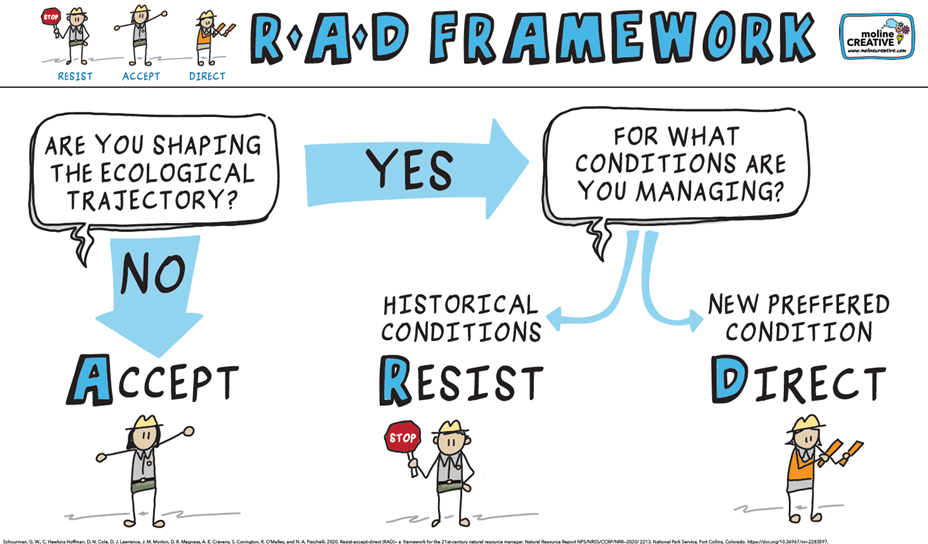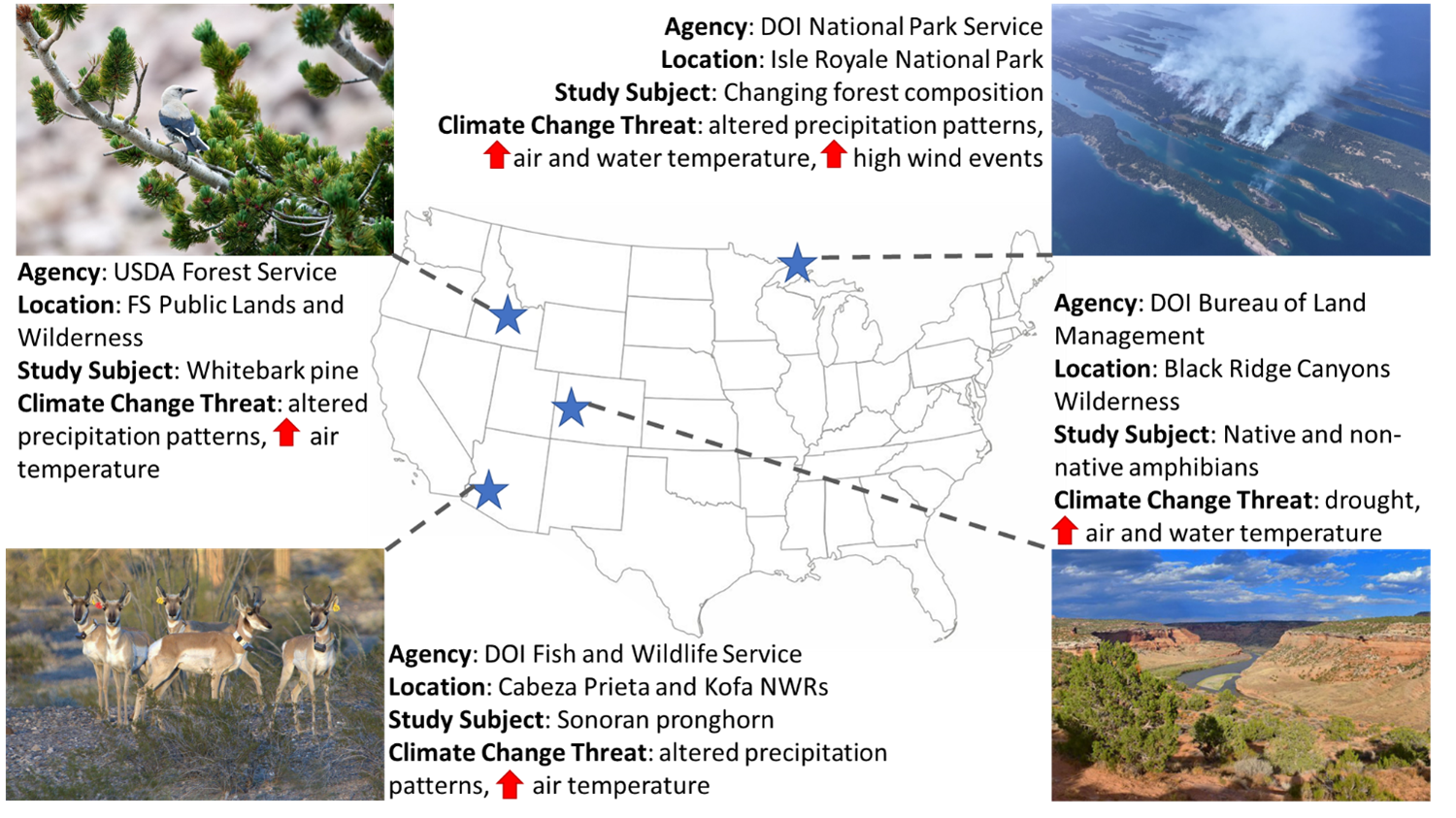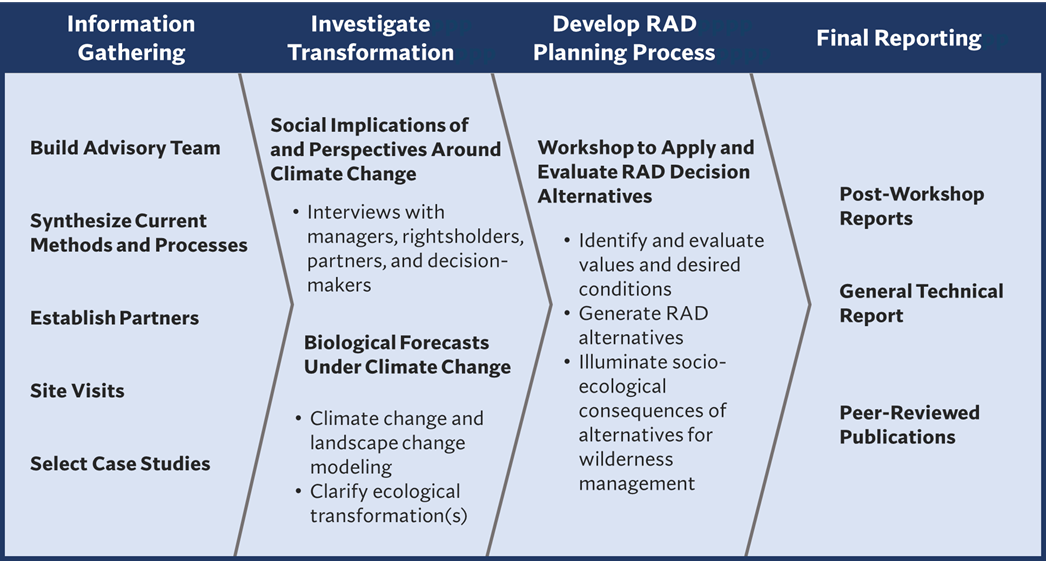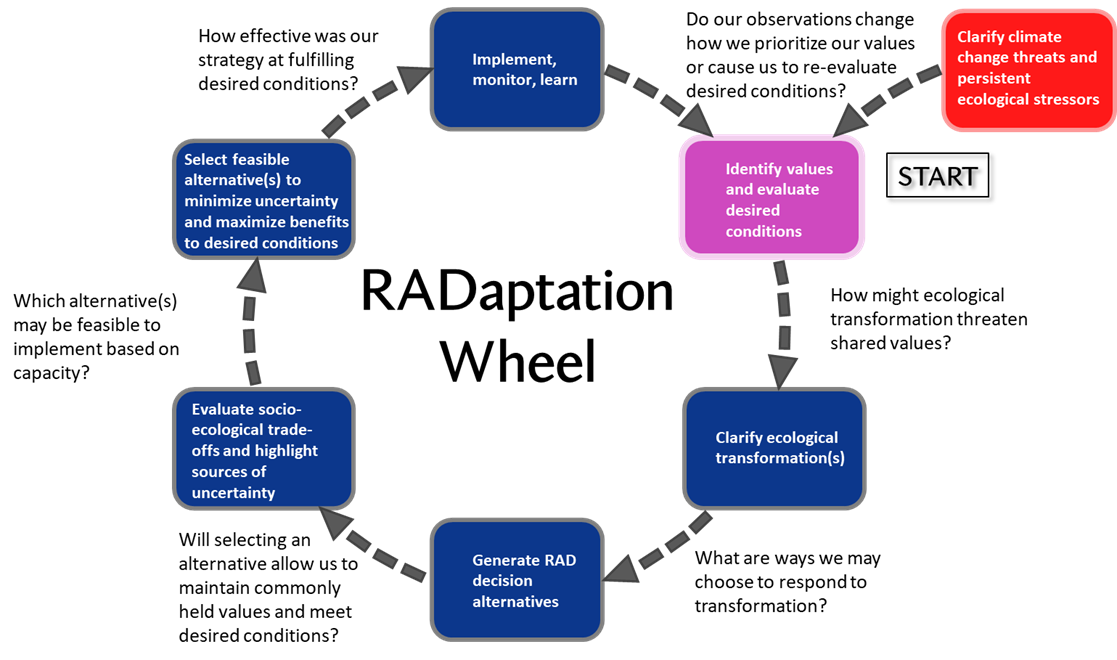RAD Decisions in RAD Landscapes: Adaptive Decision-Making in Wilderness
11/18/24
This is a Science Spotlight from the Aldo Leopold Wilderness Research Institute, which generates knowledge to support interagency wilderness stewardship.
Authors: Kira Hefty, Jaclyn Rushing, Sean Parks, Erana Taylor, Teresa Hollingsworth, Chris Armatas, Kellie Carim, Lauren Redmore, Katherine Zeller.
Background
Climate change has contributed to unprecedented shifts in ecological patterns and processes. Altered ecological properties may lead to changes in ecosystem structure, function, and composition and impact ecosystem services and relationships among people and natural communities. When compounded by existing stressors and threats such as wildfire, pests, disease, invasive species, and human development, ecological change may become irreversible. Ecological transformation, or the emergence of new ecosystem states that differ from known historical conditions, makes it difficult for land stewards and partners to delineate management goals and adhere to current management strategies. Growing concern and recognition that traditional or familiar stewardship strategies may no longer support resilient ecological communities has driven land stewards and their partners to seek alternative solutions to address complex problems under climate change.
Climate change-driven ecological transformation is a diffuse and complex issue impacting landscapes globally, regardless of jurisdiction and protection status. In the United States, the National Wilderness Preservation System (NWPS) includes over 100 million acres of land protected from rapid post-European settlement and widespread industrialization. Guiding policy under the 1964 Wilderness Act mandates that lands designated as part of the NWPS be preserved in their natural state, wherein the character of the landscape is primarily influenced by the forces of nature and absent of human development or human trammeling that may otherwise manipulate or permanently modify wilderness character. In addition, the NWPS is managed to preserve opportunities for solitude or primitive recreational experiences and other features of value, such as ecological processes and cultural features that existed upon designation. Nevertheless, despite these high levels of protection, the NWPS remains susceptible to climate change-driven challenges such as increasing temperatures, altered precipitation events, fluctuating disturbance regimes, and altered phenological patterns. Cascading indirect effects of human development, including climate change, threaten the natural quality of wilderness and were not anticipated when the 1964 Wilderness Act was signed into law. Lack of guidance and sometimes competing priorities outlined under the Wilderness Act has created a conundrum for land stewards, rightsholders, and partners attempting to address climate change-related challenges within the NWPS. The same high levels of protection afforded to Wilderness to save lands from direct human impacts are often dually perceived as barriers to addressing climate change-driven threats, including ecological transformation. Whether or not to pursue active management, which may involve short- or long-term trammeling of wilderness, to address transforming wilderness ecosystems is a wicked problem faced by all wilderness managers and stewards.
To unravel this wicked problem, scientists at ALWRI will use the Resist-Accept-Direct Framework (RAD) framework as a tool to both illuminate a decision-space and evaluate management goals to address climate change-driven ecological transformation for four case studies, one per wilderness-administering agency (Figure 1). The RAD framework presents three avenues for responding to ecological transformation: 1) Resist the transformation by maintaining historical conditions through efforts such as restoration and resilience-building, 2) Direct the transformation by actively shaping ecological change toward a preferred new condition, or 3) Accept the transformation by intentionally allowing ecological composition, structure, and function to change autonomously. RAD has a unique advantage for wilderness managers because of its incorporation of acceptance as a possible strategy. However, rather than accepting ecosystem changes implicitly, RAD provides a decision space wherein the relative value of acceptance can be fully examined and compared to alternative resistance or direct strategies.

Figure 1: Decision points to guide the use and implementation of the resist-accept-direct (RAD) framework for responding to ecological transformation under climate change.
Objectives
Scientists will work with managers, leadership, and management partners on each case study to define values and desired conditions, explore the RAD decision space to meet desired conditions, and evaluate the socio-ecological trade-offs inherent in selecting R-A-D strategies to achieve management goals. Collectively, this work has three primary objectives:
- Generate a widely applicable process of how to use the RAD framework in designated wilderness
- Provide science and decision support for management challenges related to climate change in wilderness
- Advance our understanding of the trade-offs, uncertainties, opportunities, and limitations for addressing climate change impacts within designated wilderness

Figure 2: Case study locations and descriptions for the RAD Decisions in Rad Landscapes: Adaptive Decision-Making in Wilderness research project, 2022-2025.
Methods
The project consists of four stages (Table 1): 1) information gathering to better understand current ecological conditions and challenges as well as meet and establish project partners, 2) biological and social science investigation to assess the impacts of climate change-driven transformation and perceived limitations and barriers to addressing related challenges in wilderness, 3) workshop to establish an iterative process of integrating the RAD framework into existing planning and implementation activities (Figure 3), and 4) final reporting to summarize and deliver results of science analyses and comprehensive summaries of workshop activities. Each stage of the project was designed to inform and contribute to an adaptive management process using RAD as a tool to support intentional decision-making around climate change driven transformation for four case studies covering the following themes, 1) Ephemeral riparian community conservation (BLM), 2) Whitebark pine restoration (FS), 3) Sonoran pronghorn recovery (FWS), and 4) Forest composition change (NPS).

Table 1: Project development and description for the RAD Decisions in Rad Landscapes: Adaptive Decision-Making in Wilderness research project, 2022-2025.
Information Gathering and Social and Biological Investigation
BLM: Ephemeral Riparian Community Conservation
Problem Statement
The western slope of the Rocky Mountains in Colorado, USA, is estimated to be warming twice as fast as the global average. This rapid change in climate, coupled with pre-existing ecological stressors, is already contributing to extensive shifts in ecological patterns and processes within the Black Ridge Canyons Wilderness (BRCW). Riparian communities within the BRCW are particularly vulnerable to ecological change under climate change. In particular, native amphibian species that exist within and surrounding ephemeral pools along canyon bottoms are highly responsive to change in both abiotic and biotic environmental properties. Some amphibian species with higher adaptive capacity, such as Woodhouse’s and red-spotted toads, may tolerate moderate changes in habitat conditions, including drying and increased temperatures, by adjusting the timing and duration of life history events. More vulnerable species with limited adaptive capacity, such as the canyon treefrog, may become extirpated under degrading habitat quality. Subsequent changes in species richness and population abundance of native amphibians serve as strong indicators of overall ecosystem health as habitat conditions change under climate change. However, limited ecological data on native amphibian populations and their habitat as well as uncertainty associated with shifting ecological baselines under climate change have made it difficult for managers and decision-makers to confidently identify and prescribe beneficial management strategies for ephemeral riparian communities.
Biological and Social Science Analysis
Given limited available data, biological analyses will rely heavily on expert opinion and existing relevant literature. Through a series of regularly held meetings, a group of scientists and managers with local- and subject-level expertise will be consulted to better understand how native canyon riparian communities may be impacted by projected climatic changes. To anticipate how environmental conditions may change for ephemeral riparian communities, scientists will use climate change modeling to generate three plausible and divergent climate scenarios for the BRCW. For each climate scenario, the interdisciplinary team of experts will discuss how riparian communities and native amphibians may be impacted. Facilitated discussions for each scenario will investigate potential drivers of ecological change and anticipated ecological outcomes. In particular, the following topics were highlighted in discussion: disturbance events (ex: wildfire and convective summer storms), hydrology (ex: runoff and pool hydroperiod), native amphibians (richness and abundance), invasive bullfrogs, and disease. Both landscape-level and site-specific impacts were considered during discussion.
FS: Whitebark Pine Restoration
Problem Statement
Climate change is leading to large-scale elevational and latitudinal range shifts of numerous species. In western North America, forested communities are experiencing shifts in species composition associated with increasing temperatures, changing disturbance regimes, beetle damage, drought, and fungal infection. Whitebark pine, a geographically widespread upper subalpine tree species, exists largely within designated wilderness areas that are afforded greater protection as compared to surrounding public and privately owned lands. Nevertheless, climate change, associated disturbances, and disease are causing an increase in tree mortality of this foundation species in parts of its range. Loss of whitebark pine may ecologically destabilize subalpine communities and reduce seed collecting opportunities important to Native American heritage. To address these core issues, it essential to identify areas that may be short- or long-term refugia for whitebark pine, areas which represent diminishing climatic suitability, areas which will become climatically suitable in the future, and areas that may serve as important nodes of genetic connectivity through time. The USDA Forest Service manages the majority of whitebark pine in the United States and has been mandated to identify region-specific core areas for whitebark pine restoration activities. Although numerous region-specific efforts are underway to develop restoration strategies for whitebark pine, there is a still a need for national-level, transboundary coordination to support unified and consistent range-wide conservation and planning efforts for whitebark pine.
Biological and Social Science Analyses
Science to inform a RAD decision space for whitebark pine will focus on a combination of ecological and social science modeling efforts. Ecological modeling will include identifying geographic areas of recent and future climatic suitability for whitebark pine. Forest Inventory and Analysis (FIA) data will be used to inform a model that will produce gridded projections of climatically suitable habitat for whitebark pine on a national-level. We will use future projections to highlight potential refugia and critical nodes of connectivity. Due to the unpredictability of climate futures and ecological complexities, such depictions are meant to be illustrative rather than strictly predictive. However, by producing these models using the best available data, our visualizations of possible futures are meant to provide reference points which managers can incorporate into adaptive planning repeatedly over time as environmental realities become apparent.
In addition to modelling recent and future climatically suitable habitat, this case study will examine barriers and facilitators to whitebark pine conservation through the lenses of transboundary adaptation efforts and social perceptions of intervening to promote species dispersal and establishment within and among patches of designated wilderness. Interviews with managers and affected rightsholders will seek to understand the role of transboundary conservation efforts across wilderness boundaries, Forest Service regions, and other land management entities (e.g., the National Park Service and Tribes) in whitebark pine response decisions within wilderness as well as agency culture around interventions in wilderness and how it relates to selecting resist, accept, or direct climate response options for whitebark pine. Transboundary efforts will be included in the modeling and RAD decision space for consideration of how a patchwork RAD approach both includes and affects wilderness whitebark pine populations. This example of how RAD can be applied to a complex management challenge will incorporate our model results as an illustration of how science can help inform the broader RAD decision-making process.
FWS: Sonoran Pronghorn Recovery
Problem Statement
Endangered species conservation in an era of climate change is a complex task. Restoring or expanding habitat availability to promote species recovery becomes particularly challenging as baseline ecological conditions transform in response to changing climatic conditions. Additionally, when current or historical habitat exists within designated wilderness, the use of active management interventions to improve habitat conditions aligned with objectives of the 1973 Endangered Species Act (ESA) may conflict with pre-existing laws pertaining to the 1964 Wilderness Act. In southern Arizona, habitat for the federally endangered Sonoran pronghorn exists both outside and within designated wilderness. Recovery efforts have primarily focused on improving habitat conditions outside wilderness and explicitly within the bounds of the historical range of the species. It is unknown how current management strategies or alternative strategies that incorporate wilderness or expand beyond the historical range of Sonoran pronghorn may promote or detract from landscape connectivity in different climate futures.
Biological and Social Science Analyses
Science to inform the RAD decision space will focus on modeling current and future habitat conditions and connectivity of Sonoran pronghorn populations within and beyond their current reintroduced range. Additionally, we will evaluate the social challenges of prioritizing conservation efforts for an endangered species within designated wilderness characterized by drought, human activity, and contrasting land use designations. Extent of current and future habitat availability both within and outside wilderness is uncertain. Genetic diversity, human interference, and water and forage availability are key concerns in current pronghorn recovery zones. RAD options have yet to be explored for wilderness habitat where current subpopulations exist. Issues of scale in available climate data complicate the evaluation of current and future habitat quality, but ALWRI modeling and analysis may help address this uncertainty. Additionally, RAD-driven scenario planning spanning wilderness and non-wilderness boundaries can evaluate future pronghorn habitat quality under different climate trajectories. Such models may include assessments of the effects of installing water guzzlers and forage enhancement plots, climate change projections, and expansion of the reintroduction area on habitat use and connectivity for Sonoran pronghorn across space and time. How managers view interventions in wilderness, including water installations, will be assessed through interviews that will seek to understand the roles of manager and invested partner perceptions on past and future desired conditions as well as barriers and facilitators to implementing resist, accept, and direct options. Particular attention will be paid to the intersection of the ESA and the Wilderness Act regarding interventions in designated wilderness for pronghorn recovery.
NPS: Forest Composition Change
Problem Statement
Reduced dispersal capacity and geographic isolation make ecological communities on island systems particularly vulnerable to large-scale ecological transformations associated with climate change. Transforming vegetation composition and structure associated with changing climatic conditions and disturbances such as wildfire can lead to cascading effects up the trophic hierarchy, ultimately impacting ecological patterns and processes that support communities of extant native species. At Isle Royale National Park, charismatic moose and wolf populations attract visitors from around the world to this small (206.7 mi²) island wilderness at the southern edge of boreal forest in North America. However, the future of moose and wolf populations is uncertain given anticipated vegetation shifts caused by changing climatic conditions compounded by disturbance events. Whether these iconic species can be sustained on Isle Royale in perpetuity remains highly uncertain and may require significant management intervention to maintain current forested vegetation conditions in designated wilderness.
Biological and Social Science Analyses
Science to inform the RAD decision space will focus both on modeling changing habitat conditions that support current moose and wolf populations as well as surveying public and manager perceptions on intervening to preserve habitat or deliberately accepting anticipated changes to habitat. To assess changing habitat conditions through time, we will develop climate and disturbance (e.g., wildfire) driven vegetation change projections across Isle Royale. For example, LANDIS ecosystem modeling and/or spatially explicit climate envelope modeling under multiple climate scenarios can show relative change and explore the degree and type of forest change for each scenario as well as implications for management. Specific model predictors may include climate change scenarios, fire regime, pest damage, and moose browse. Additionally, management scenarios may be explicitly modeled to assess the socio-ecological consequences of direct intervention (resist or direct) or inaction. These management scenarios will be developed through virtual and in-person meetings with management partners. The role of individual perception regarding management intervention, past and future desired conditions, and barriers and facilitators to implementing RAD alternatives will be assessed through individual meetings and interviews with managers and invested partners. Additionally, this case study will evaluate the delivery and uptake of previous climate modeling efforts to create best practices for climate adaptation science delivery that we will use for the delivery of our research.
Develop RAD Planning Process
The purpose of each workshop was to support overarching project goals by informing and evaluating a decision space using the RAD framework to support iterative climate change adaption planning and related projects in wilderness. During the workshop, participants followed an adaptive management process which leveraged the RAD framework to generate and evaluate decision alternatives in wilderness through climate change (Figure 3). The workshop was structured around four learning objectives:
- Orient each case study in the broader challenge of wilderness management in an era of climate change
- Identify desired conditions surrounding the focal ecological transformation that reflects all perspectives
- Understand the utility of RAD as a tool for responding to ecological transformation
- Develop a feasible and repeatable workflow to evaluate RAD decision alternatives
Each learning objective was achieved through a combination of scientific inquiry, facilitated discussion, and small group activities. Scientific inquiry was completed prior to the workshop by scientists at the Aldo Leopold Wilderness Research Institute and project partners. Both biological and social science investigations were leveraged to better understand how ecological conditions are changing for each case study and how land stewards and their partners perceive this change and their ability to prepare for or respond to climate change-driven transformation. Preliminary and final results of subsequent analyses were shared with workshop participants to characterize potential ecological transformation and to encourage further discussion concerning perceived limitations, barriers, and opportunities to conserving resources and species. Facilitated small-group activities and discussion encouraged co-production of ideas and decision alternatives that were further examined through the RAD framework.

Figure 3: Iterative planning process integrating the resist-accept-direct (RAD) framework as a tool to address climate change-driven ecological transformation in federally designated wilderness.
Progress to Date
All case studies and project collaborators have been established. Scientists at ALWRI have completed interviews for all four case studies and biological analyses have been completed for the BLM, FS, and NPS case studies. Workshops have been conducted for the BLM and NPS case studies. Current cross-cutting findings include:
- All managers feel climate change has directly or indirectly impacted their workload, responsibilities, or the success of current management activities
- Managers generally feel limited in their capacity to respond to climate change
- Management actions which constitute trammeling may be necessary to preserve historical characteristics
- There is a high degree of uncertainty regarding the effectiveness of any single decision alternative as a long-term strategy for conserving native flora and fauna through climate change
- Familiar resist or accept options may no longer be desirable long-term options to achieve desired conditions in wilderness
- Direct actions are inherently risky, however, they may be more effective at achieving desired conditions long-term